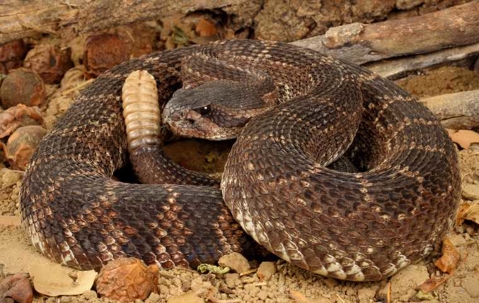Rattlesnakes are a distinctive and easily recognizable group of venomous snakes known for their unique features. While there are various species of rattlesnakes, they share several common characteristics:
Size and Shape: Rattlesnakes vary in size, but they typically range from 1 to 8 feet in length, depending on the species. They have a thick, cylindrical body with a triangular-shaped head that is wider than their neck.
Coloration: Rattlesnakes come in a range of colors and patterns that help them blend into their natural habitats. Common colors include shades of brown, gray, and green, with patterns that can resemble diamonds, bands, or mottled markings.
Rattle: One of the most distinctive features of rattlesnakes is their rattle, which is located at the end of their tail. The rattle consists of interlocking segments made of keratin. When threatened or agitated, rattlesnakes shake their tails, producing a buzzing sound that serves as a warning to potential predators or threats.
Venomous Fangs: Rattlesnakes are equipped with hollow, retractable fangs located in the front of their upper jaw. These fangs deliver venom into their prey, which helps immobilize and digest their food.
Pits: Rattlesnakes are pit vipers, which means they have heat-sensitive pits located between their eyes and nostrils. These pits help them detect warm-blooded prey in the dark, aiding in hunting.
Scales: Rattlesnakes have keeled scales, which give their skin a rough texture. These scales provide protection and help reduce water loss.
Eyes: Rattlesnakes have vertically elliptical pupils, which can adjust to different lighting conditions. They have excellent vision, particularly for detecting movement.
Rattlesnakes can vary in appearance based on their species and geographical location, so there may be some differences in coloration and patterns among different rattlesnake populations. While they are fascinating creatures, it's crucial to exercise caution and maintain a safe distance when encountering rattlesnakes in the wild, as they are venomous and can deliver a potentially dangerous bite if provoked.
How Big Are Rattlesnakes?
Rattlesnakes come in various sizes, with their length primarily determined by the species, age, and environmental conditions. On average, adult rattlesnakes typically range from 1 to 8 feet (30 centimeters to 2.4 meters) in length. However, some exceptional individuals can exceed 8 feet in length. The size of a rattlesnake can also depend on factors such as its geographical location and access to food.
Here's a general size breakdown of some common rattlesnake species:
Western Diamondback Rattlesnake (Crotalus atrox): These are among the largest rattlesnake species and can reach lengths of up to 7 feet or more.
Eastern Diamondback Rattlesnake (Crotalus adamanteus): Eastern diamondbacks are known to be the largest rattlesnakes and can grow up to 8 feet or longer.
Timber Rattlesnake (Crotalus horridus): Timber rattlesnakes are generally smaller, averaging around 3 to 5 feet in length.
Mojave Rattlesnake (Crotalus scutulatus): Mojave rattlesnakes are medium-sized and typically range from 2 to 4 feet in length.
Sidewinder Rattlesnake (Crotalus cerastes): Sidewinders are smaller, with an average length of around 1 to 2 feet.
The size of a rattlesnake can vary within a species, and factors such as nutrition, genetics, and environmental conditions can influence their growth. When encountering a rattlesnake in the wild, it's essential to exercise caution and avoid provoking them, as they are venomous and should be treated with respect and left undisturbed.
What Color Are Rattlesnakes?
Rattlesnakes come in a range of colors and patterns, which can vary depending on the species, geographic location, and environmental factors. The coloration of rattlesnakes is an adaptation that helps them blend into their natural habitats and may serve as camouflage. Here are some common colors and patterns seen in rattlesnakes:
Shades of Brown: Many rattlesnake species have brown as a primary color. This can range from light tan to dark brown or even reddish-brown. The specific shade can vary among individuals and populations.
Gray: Some rattlesnakes have a grayish coloration. The Timber Rattlesnake, for example, often exhibits gray tones.
Green: In certain regions, rattlesnakes may have a greenish hue. This is more common among young rattlesnakes and individuals in areas with lush vegetation.
Pattern: Rattlesnakes often have patterns on their scales that can take the form of bands, blotches, or diamond-shaped markings. These patterns can be various shades of brown, black, or gray and help them blend into their surroundings.
Mottled: Some rattlesnakes have a mottled or speckled appearance, which helps break up their outline and aids in camouflage.
Albino or Melanistic: While less common, albino rattlesnakes lack pigment and are typically pale with pink or yellowish scales. Conversely, melanistic rattlesnakes have an excess of pigment, resulting in dark black or brown coloration.
Color Variation: Rattlesnake coloration can vary significantly even within the same species. This diversity can make it challenging to identify them solely based on color.
The coloration of rattlesnakes is not a foolproof method for identification, as it can vary considerably. Other characteristics, such as the presence of a rattle on the tail and the shape of the head, are more reliable indicators of a rattlesnake. Regardless of their coloration, it's crucial to exercise caution and maintain a safe distance when encountering rattlesnakes in the wild, as they are venomous and can deliver a dangerous bite if threatened.

